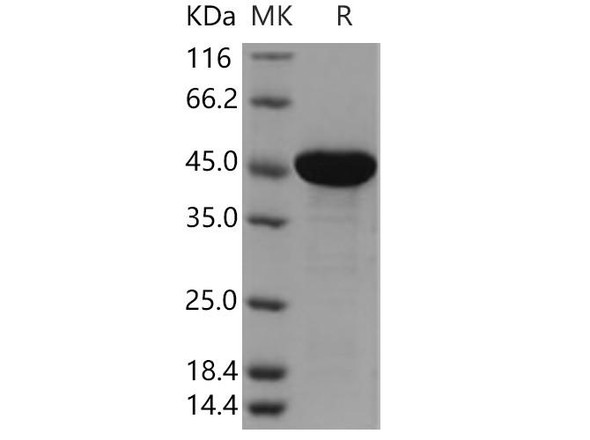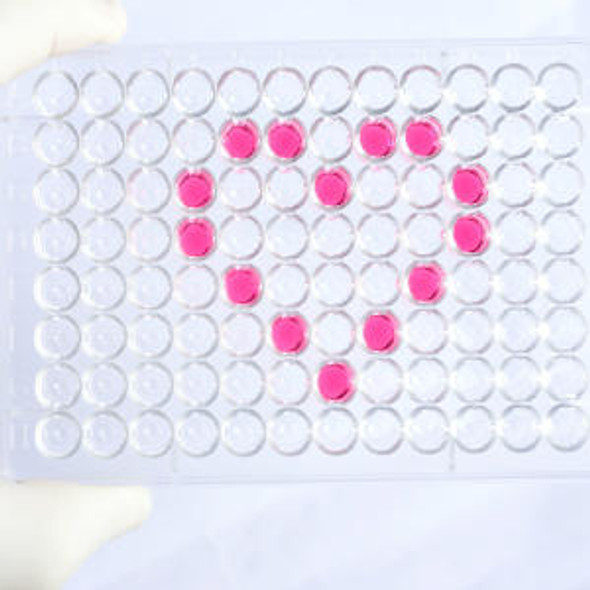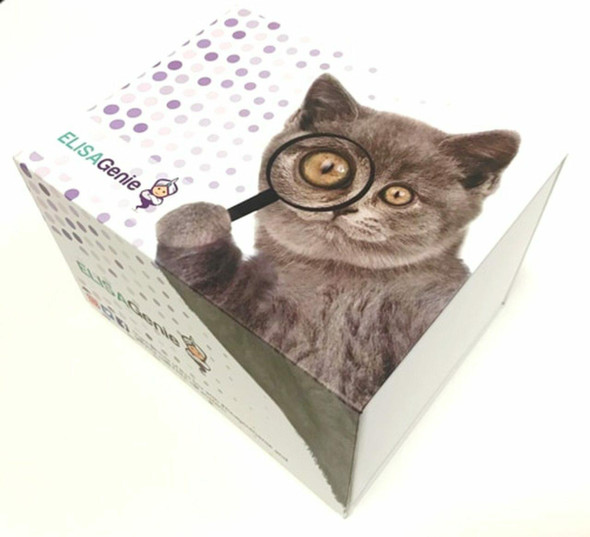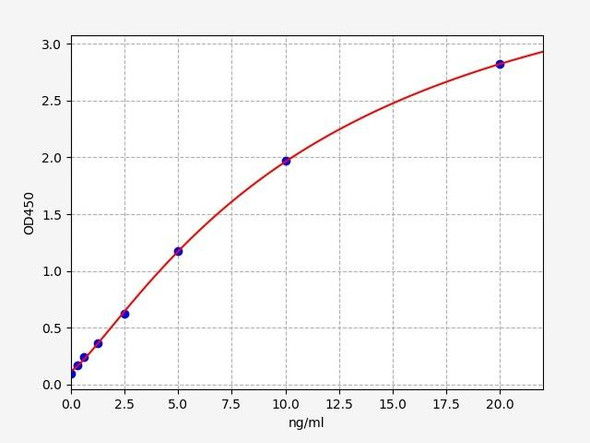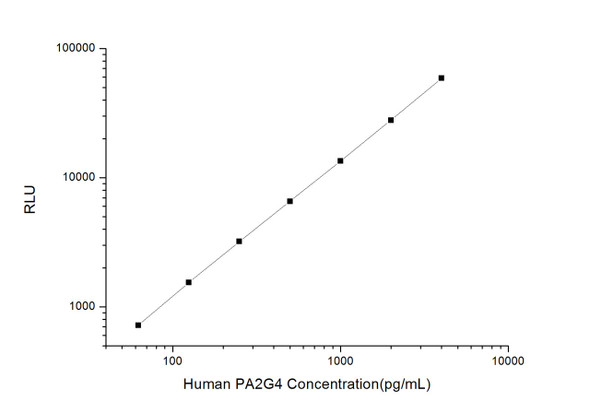Description
| Product Name: | Human PA2G4 Recombinant Protein |
| Product Code: | RPPB4180 |
| Size: | 25µg |
| Species: | Human |
| Target: | PA2G4 |
| Synonyms: | Proliferation-associated protein 2G4, Cell cycle protein p38-2G4 homolog, hG4-1, ErbB3-binding protein 1, PA2G4, EBP1, p38-2G4. |
| Source: | Escherichia Coli |
| Physical Appearance: | Sterile filtered colorless solution. |
| Formulation: | The PA2G4 protein solution contains 20mM Tris-HCl buffer (pH8.0) and 10% glycerol. |
| Stability: | Store at 4°C if entire vial will be used within 2-4 weeks. Store, frozen at -20°C for longer periods of time. For long term storage it is recommended to add a carrier protein (0.1% HSA or BSA).Avoid multiple freeze-thaw cycles. |
| Purity: | Greater than 95.0% as determined by SDS-PAGE. |
| Amino Acid Sequence: | MSGEDEQQEQ TIAEDLVVTK YKMGGDIANR VLRSLVEASS SGVSVLSLCE KGDAMIMEET GKIFKKEKEM KKGIAFPTSI SVNNCVCHFSPLKSDQDYIL KEGDLVKIDL GVHVDGFIAN VAHTFVVDVA QGTQVTGRKA DVIKAAHLCA EAALRLVKPG NQNTQVTEAW NKVAHSFNCT PIEGMLSHQL KQHVIDGEKT IIQNPTDQQK KDHEKAEFEV HEVYAVDVLV SSGEGKAKDA GQRTTIYKRD PSKQYGLKMK TSRAFFSEVE RRFDAMPFTL RAFEDEKKAR MGVVECAKHE LLQPFNVLYE KEGEFVAQFK FTVLLMPNGP MRITSGPFEP DLYKSEMEVQ DAELKALLQS SASRKTQKKK KKKASKTAEN ATSGETLEEN EAGDLEHHHH HH |
PA2G4 belongs to the peptidase M24C family and functions as an RNA-binding protein involved in cellular proliferation and differentiation processes. PA2G4 is a component of pre-ribosomal ribonucleoprotein complexes, participating in ribosome assembly and regulating the later steps of rRNA processing. Also, PA2G4 interacts with ErbB-3 and may function as a modulator of the ErbB-3 mediated signal transduction pathway by regulating the effects of Neuregulin-1. Furthermore, PA2G4 is a transcriptional co-repressor of androgen receptor-regulated genes and other cell cycle regulatory genes through its interactions with histone deacetylases. PA2G4 is implicated in growth inhibition and the induction of differentiation of human cancer cells. In addition, PA2G4 mediates cap-independent translation of specific viral IRESs (internal ribosomal entry site). PA2G4 associates with 28S, 18S and 5.8S mature rRNAs, several rRNA precursors and probably U3 small nucleolar RNA.
PA2G4 produced in E.Coli is a single, non-glycosylated polypeptide chain containing 402 amino acids (1-394 a.a.) and having a molecular mass of 44.8kDa.PA2G4 is fused to 8 amino acids His Tag at C-terminus and purified by proprietary chromatographic techniques.
| UniProt Protein Function: | Ebp1: May play a role in a ERBB3-regulated signal transduction pathway. Seems be involved in growth regulation. Acts a corepressor of the androgen receptor (AR) and is regulated by the ERBB3 ligand neuregulin-1/heregulin (HRG). Inhibits transcription of some E2F1-regulated promoters, probably by recruiting histone acetylase (HAT) activity. Binds RNA. Associates with 28S, 18S and 5.8S mature rRNAs, several rRNA precursors and probably U3 small nucleolar RNA. May be involved in regulation of intermediate and late steps of rRNA processing. May be involved in ribosome assembly. Mediates cap-independent translation of specific viral IRESs (internal ribosomal entry site). Belongs to the peptidase M24 family. |
| UniProt Protein Details: | Protein type:Nucleolus; Transcription, coactivator/corepressor; Nuclear receptor co-regulator Chromosomal Location of Human Ortholog: 12q13.2 Cellular Component: nucleoplasm; membrane; cytoplasm; nucleolus; nucleus; ribonucleoprotein complex Molecular Function:protein binding; DNA binding; ubiquitin protein ligase binding; transcription factor activity Biological Process: regulation of translation; cell proliferation; transcription, DNA-dependent; negative regulation of transcription, DNA-dependent; positive regulation of cell differentiation; cell cycle arrest; rRNA processing; negative regulation of apoptosis |
| NCBI Summary: | This gene encodes an RNA-binding protein that is involved in growth regulation. This protein is present in pre-ribosomal ribonucleoprotein complexes and may be involved in ribosome assembly and the regulation of intermediate and late steps of rRNA processing. This protein can interact with the cytoplasmic domain of the ErbB3 receptor and may contribute to transducing growth regulatory signals. This protein is also a transcriptional co-repressor of androgen receptor-regulated genes and other cell cycle regulatory genes through its interactions with histone deacetylases. This protein has been implicated in growth inhibition and the induction of differentiation of human cancer cells. Six pseudogenes, located on chromosomes 3, 6, 9, 18, 20 and X, have been identified. [provided by RefSeq, Jul 2008] |
| UniProt Code: | Q9UQ80 |
| NCBI GenInfo Identifier: | 13632817 |
| NCBI Gene ID: | 5036 |
| NCBI Accession: | Q9UQ80.3 |
| UniProt Secondary Accession: | Q9UQ80,O43846, Q9UM59, |
| UniProt Related Accession: | Q9UQ80 |
| Molecular Weight: | 394 |
| NCBI Full Name: | Proliferation-associated protein 2G4 |
| NCBI Synonym Full Names: | proliferation-associated 2G4, 38kDa |
| NCBI Official Symbol: | PA2G4�� |
| NCBI Official Synonym Symbols: | EBP1; HG4-1; p38-2G4�� |
| NCBI Protein Information: | proliferation-associated protein 2G4; erbB3-binding protein 1; ErbB-3 binding protein 1; ErbB3-binding protein Ebp1; cell cycle protein p38-2G4 homolog; proliferation-associated 2G4, 38kD |
| UniProt Protein Name: | Proliferation-associated protein 2G4 |
| UniProt Synonym Protein Names: | Cell cycle protein p38-2G4 homolog; hG4-1; ErbB3-binding protein 1 |
| Protein Family: | Proliferation-associated protein |
| UniProt Gene Name: | PA2G4�� |
| UniProt Entry Name: | PA2G4_HUMAN |


